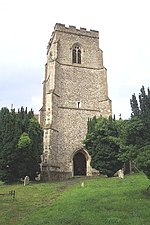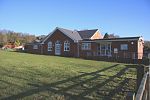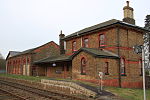Grundisburgh

Grundisburgh () is a village of 1,584 residents situated in the English county of Suffolk. It is in the East Suffolk district, six 6 miles (10 km) north-east from Ipswich and 4 miles (6 km) north-west of Woodbridge located on the B1079. Flowing through the village are the rivers Lark and Gull. The finding of Ipswich and Thetford-type pottery suggests that there was settlement in the Middle Saxon era. The village is recorded in the Domesday Book of 1086 as "Grundesbur", "Grundesburg", "Grundesburh" or "Grundesburc". Grundisburgh is pronounced "Gruns-bruh". The village has a primary school, a Church of England church and a Baptist chapel as well as one pub, The Dog. The Grundisburgh and District News is a newspaper which is published by volunteers every three months and provides news for Grundisburgh and the surrounding villages and hamlets. There are two fords in the village. The village is the setting for the novel A Wicked Deed by Susanna Gregory. Grundisburgh Primary School is a medium-sized school with 131 pupils at the time of the last Ofsted inspection. It is located in a modern building in Alice Driver Road which was built in 1989 after spending 115 years at the Old School next to St Mary's Church. The Old School building has now been converted into affordable housing, which was opened by John Gummer MP in July 1994.
Excerpt from the Wikipedia article Grundisburgh (License: CC BY-SA 3.0, Authors, Images).Grundisburgh
The Green, East Suffolk
Geographical coordinates (GPS) Address Nearby Places Show on map
Geographical coordinates (GPS)
| Latitude | Longitude |
|---|---|
| N 52.11241 ° | E 1.2462 ° |
Address
The Green
The Green
IP13 6TA East Suffolk
England, United Kingdom
Open on Google Maps









